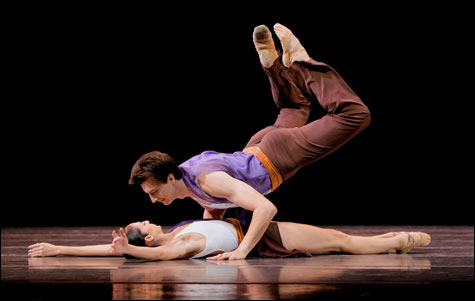
OPUS 111: Twyla Tharp's 2008 piece got such a dry reading from Pacific Northwest Ballet, it seemed a bit pedantic. |
In early January, New York hosts a huge concentration of dance, theater, and music performances programmed around the annual conference of the Association of Performing Arts Presenters. For this conclave, bookers, company managers, publicists, and artists gather to share information, do intensive networking, and scope out the performance territory. The audience gets the benefit of a citywide showcase. If you make astute choices among the hundreds of shows, you can survey the state of the art in a few days.
I saw nearly 40 different dance entries over a long weekend; what follows will touch on the highlights. One thing that impressed me was that dance invention seems to be making a comeback as a major challenge for young choreographers after years of being stirred into the multimedia stew. It's possible, though, that the showcase format — some offerings were limited to 15-minute excerpts in studio settings — afforded only a stripped-down view of more elaborate works.
Two of the most interesting people I saw whose work was unfamiliar to me, Kate Weare and Brian Brooks, were reinventing movement in personal ways. Weare's Gone Before and Rattling was one of a dozen numbers in a showcase at NYU's Skirball Center. No programs were supplied, so I don't know whether these were excerpts from larger pieces. A series of duets for four dancers in alternating partnerships, Gone Before was unconcerned with the flashy manipulations ever-present in mainstream contemporary dance. Weare uses a simple but centrally powered movement vocabulary. The dancers clasp and nudge one another, with unexpected body parts and lots of surfaces in contact. The relationships change, from tenderness to separation, unanimity to roughness and discord. It's all quiet, matter-of-fact, sometimes witty but never melodramatic. You seem to see subtle shifts in the relationships as the dance goes on. I think because we're not distracted by multiple pirouettes and superhuman stretches, we relate more personally to the dancers through Weare's deep explorations.
Getting past preconceived ballet and dance techniques to reveal the ordinary dancing person has been a mantra ever since the postmodern days of the 1960s and '70s, but it's great to see a new generation of dancers working the possibilities. Brooks said at a morning showcase one day that he was "finding where my core of making movement lies. We're not moving an inch unless we have to." Words to that effect have been uttered for a century by modern dancers from Isadora Duncan to Laura Dean and beyond, with new consequences every time.
Brooks's Motor — an excerpt from a group work in progress — and his own solo I'm Going To Explode Now (2007) proved that the idea of "organic" movement hasn't run out of steam. Both dances start with a kernel of movement, a gesture, and develop seamlessly, triggering the whole body into action, and then into space and interaction. The two couples in Motor begin with an arm wrapping around a partner's neck, an answering clasp of the shoulder. Move by move they achieve an embrace, a tangle, and ultimately a bout of wrestling. In his solo, Brooks portrays a man confined in a rigidly jittering body. An accidentally bent arm leads him out into gyrating freedom that winds back into automatism.